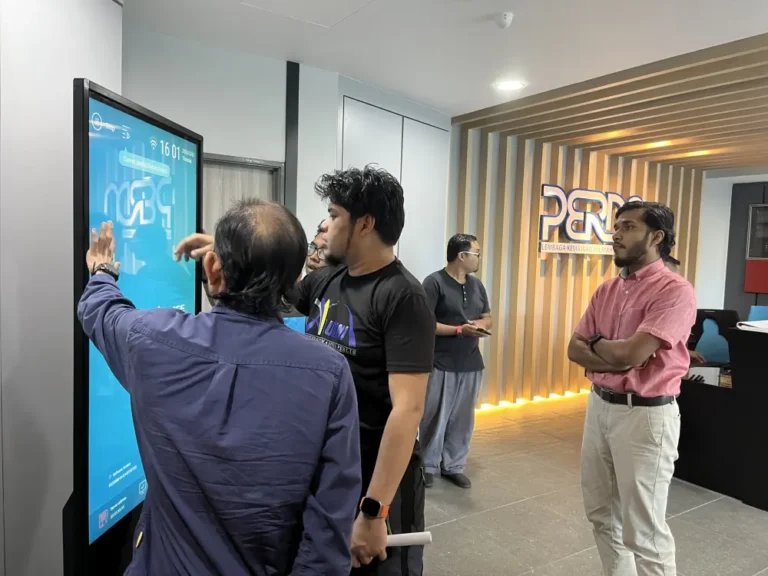History and Establishment of the Penang Regional Development Authority (PERDA)
Interactive Kiosk solutions from Arvia are designed to revolutionize the way organizations interact with their audience. With an intuitive touch interface and high-definition display, the interactive kiosk provides an engaging self-service experience in retail, government, healthcare, and education environments. It supports custom applications, secure payment systems, and queue management features—all in one sleek unit. The interactive kiosk is built for 24/7 use, offering durability and remote content control via cloud-based software. Whether you’re showcasing promotions or offering digital services, Arvia’s interactive kiosk ensures faster service, reduced operational costs, and enhanced user satisfaction.
The Penang Regional Development Authority (PERDA) is a vital government agency that plays a key role in regional planning and rural development in Penang. Established officially on June 1, 1983, under the Penang Regional Development Authority Act 282, PERDA was envisioned as a strategic institution to uplift rural communities, stimulate economic growth, and enhance infrastructure in the region.
The foundation of PERDA can be traced back to a Cabinet proposal dated March 3, 1982, which initially aimed to create the Penang Agricultural Development Authority (PADA). This earlier idea focused on agricultural advancement. However, as policy discussions matured, there was a broader recognition that Penang’s development needs extended beyond agriculture. Thus, the scope of the proposal evolved, giving birth to the concept of PERDA as a regional development authority with a wider mandate.
On December 1, 1982, a formal Cabinet paper was prepared to outline the objectives and framework of PERDA. This led to the presentation and subsequent approval of the PERDA Establishment Bill in Parliament on December 10, 1982. The bill was passed into law and gazetted as Act 282 on March 10, 1983, providing a legal foundation for the authority’s formation.
Early Leadership and Organizational Structure
After its legal establishment, PERDA quickly began to build its organizational foundation. The first Board of Directors was appointed by Dato’ Rais Yatim, then Minister of Land and Regional Development, on June 1, 1983—the same day PERDA was officially launched. The first Board meeting took place on July 21, 1983, setting strategic direction for future operations.
On October 21, 1988, PERDA’s official jurisdictional area was gazetted, with its authority backdated to begin from June 1, 1983. This formalization enabled the agency to roll out structured development programs throughout Penang, ensuring that initiatives were carried out within defined operational boundaries.
Administrative Changes and Institutional Evolution
Throughout its history, PERDA has adapted to Malaysia’s evolving administrative landscape. On October 27, 1990, the agency was moved from the Ministry of Land and Regional Development to the Ministry of Rural Development. The name of the ministry was later changed to the Ministry of Rural and Regional Development, aligning PERDA’s activities more directly with rural development objectives on a national scale.
Later, on August 15, 2005, PERDA was repositioned under the Implementation Coordination Unit (ICU) of the Prime Minister’s Department (JPM). This change was made to improve coordination between federal and regional development agencies, ensuring PERDA’s efforts aligned with national priorities and strategies.
Digital Signage Project: Supply and Commissioning Initiative
As part of its modernization strategy, PERDA has undertaken the supply and commissioning of Digital Signage systems. This initiative marks a significant step toward embracing digital transformation to improve communication, transparency, and information dissemination in public spaces.
The Role of Digital Signage in Regional Development
Digital Signage is an essential tool in today’s digital age, especially for regional and government organizations. It provides a dynamic, real-time platform for communicating with the public, replacing outdated printed posters and notices. With digital signage, messages such as government announcements, public service campaigns, and event promotions can be shared instantly and updated remotely.
In the context of PERDA’s development initiatives, digital signage enhances operational efficiency while strengthening community outreach. It allows important updates about projects, safety information, public events, and services to be delivered across the region quickly and effectively.
Improving Public Communication Through Digital Signage
By placing digital signage systems in community centers, administrative offices, and other high-traffic locations, PERDA ensures that relevant information reaches the people where they are. These screens serve not only as notice boards but also as educational platforms and engagement tools. From promoting local entrepreneurship to announcing new infrastructure projects, the applications are far-reaching.
Furthermore, digital signage supports environmental goals by reducing paper waste. It also reduces long-term costs associated with traditional print communication. The systems are scalable and customizable, allowing PERDA to maintain branding and messaging consistency across multiple locations.


